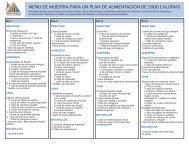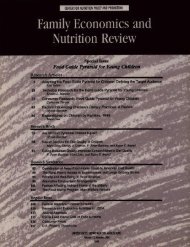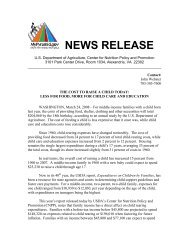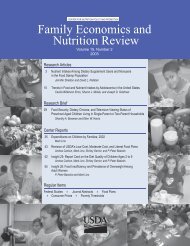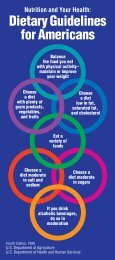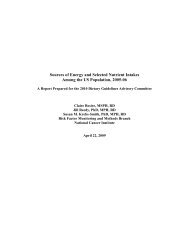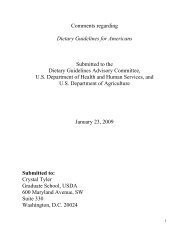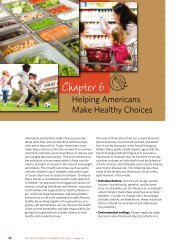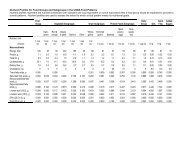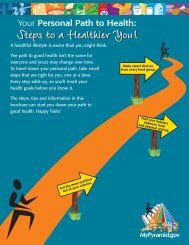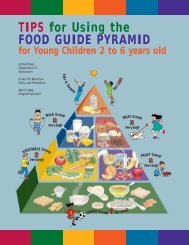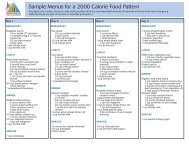Elderly Nutrition - Center for Nutrition Policy and Promotion - US ...
Elderly Nutrition - Center for Nutrition Policy and Promotion - US ...
Elderly Nutrition - Center for Nutrition Policy and Promotion - US ...
Create successful ePaper yourself
Turn your PDF publications into a flip-book with our unique Google optimized e-Paper software.
Estimation of Portion Sizes<br />
by <strong>Elderly</strong> Respondents<br />
S<strong>and</strong>ria Godwin, PhD, RD<br />
Tennessee State University<br />
Edgar Chambers IV, PhD<br />
Kansas State University<br />
This two-phase study assessed the cognitive strategies used by the elderly<br />
(individuals 65 years of age <strong>and</strong> older) <strong>and</strong> the accuracy of their estimates of<br />
reported dietary intake. In phase I of the study, we conducted interviews with<br />
118 elderly respondents who were asked to “think aloud” while estimating the<br />
portion size of solid, liquid, <strong>and</strong> amorphous (i.e., nonspecific) foods they had<br />
eaten the previous day. Respondents were given one of four sets of estimation<br />
aids, although most chose not to use these <strong>and</strong> appeared confident in estimating<br />
amounts. In phase II, 90 different elderly participants ate lunch at a university<br />
facility. Food items were pre-weighed or measured be<strong>for</strong>e being served, <strong>and</strong><br />
amounts consumed were calculated after each meal. The following day,<br />
researchers interviewed participants by using one of three r<strong>and</strong>omly assigned<br />
methods: by telephone with mostly 2-dimensional aids, by telephone without aids,<br />
or in person with 3-dimensional aids. Participants were asked to recall what they<br />
had eaten at the meal <strong>and</strong> to estimate the amount eaten. Findings from phase I<br />
suggested that elderly respondents generally chose not to use an aid to estimate<br />
portion sizes. For most foods consumed in phase II, those participants who used<br />
an aid did not have reduced estimation errors, because these commonly exceeded<br />
±25 percent.<br />
A<br />
n underst<strong>and</strong>ing of food<br />
consumption <strong>and</strong> the challenges<br />
associated with changing<br />
consumption patterns are critical to<br />
improving human health <strong>and</strong> wellbeing.<br />
One barrier to underst<strong>and</strong>ing<br />
consumption is the difficulty in<br />
measuring what people eat. Dietary<br />
recall studies, such as the National<br />
Health <strong>and</strong> <strong>Nutrition</strong> Examination<br />
Survey (NHANES) <strong>and</strong> the Continuing<br />
Survey of Food Intakes by Individuals<br />
(CSFII), have been used extensively<br />
(Thompson & Byers, 1994) to estimate<br />
food consumption <strong>and</strong> to give insight<br />
into dietary inadequacies. However,<br />
some nutrition researchers have<br />
questioned the accuracy <strong>and</strong> validity<br />
of portion-size estimation to quantify<br />
dietary intake (e.g., Cypel, Guenther, &<br />
Petot, 1997). It is important that dietary<br />
data such as portion-size estimation be<br />
as accurate as possible (McGuire,<br />
Chambers, Godwin, & Brenner, 2001;<br />
Mertz, 1992; Young & Nestle, 1995).<br />
Other authors have suggested that the<br />
accuracy of in<strong>for</strong>mation obtained from<br />
older respondents may be lower than<br />
that obtained from younger ones<br />
(Taylor-Davis & Smiciklas-Wright,<br />
1993). If this is true, the data used to<br />
determine the critical diet-related issues<br />
facing the elderly population may be<br />
less accurate than desired. This is of<br />
added importance because the proportion<br />
of elderly in the population is<br />
rising annually (U.S. Bureau of the<br />
Census, 1994).<br />
Dietary recall places substantial<br />
cognitive dem<strong>and</strong>s on the respondent—<br />
requiring an in-depth search of<br />
memory, estimation, <strong>and</strong> judgment<br />
skills (Baranowski & Domel, 1994;<br />
Fries, Green, & Bowen, 1995). Until<br />
recently, little has been known about<br />
58 Family Economics <strong>and</strong> <strong>Nutrition</strong> Review



